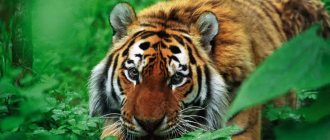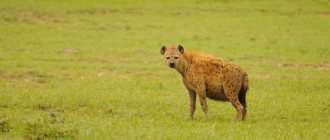Range, habitats
The Amur tiger is found in a relatively limited sector, most of which is a protected zone - this is China and the southeast of Russia, namely the banks of the Amur / Ussuri in the Primorsky and Khabarovsk territories.
As of 2003, the highest concentration of predators was observed in the foothills of Sikhote-Alin (Lazovsky district of Primorsky Krai), where every sixth Amur tiger lived. In general, when choosing habitats, tigers try to be closer to their main food (ungulates), and also proceed from the height of the snow cover and the presence of shelters, for example, creases or dense thickets of bushes.
The Amur tiger often settles in such biotopes as:
- mountains with deciduous trees;
- mountain river valleys;
- padi with forests of the Manchurian type, where oak and cedar predominate;
- clean cedar forests;
- secondary forests.
The Amur tiger has been displaced by humans from low-lying landscapes suitable for agriculture. In retaliation, babrians often inspect the outskirts of neighboring settlements in winter, when their usual food supply becomes scarce.
Relation to the Turanian tiger
In 2010, an American scientist, based on a study of fossil remains, put forward a version of the genetic relationship of the Amur tiger with the now extinct Turanian subspecies. It lived in the reed beds of Central Asia, in the territories of Iran and Transcaucasia. The last report of a meeting with a representative of the breed dates back to 1957.
According to the researcher's findings, both breeds had a common ancient ancestor who populated Central Asia.
Then, as a result of the influence of the human factor, part of the population moved further along the mainland to the east and evolved into the Amur species. However, the lack of genetic material of the historical subspecies of cupid and fresh DNA of its western counterpart prevents us from definitively elucidating this issue. It is worth noting that the topic of recreating this extinct feline has been actively discussed for several years in Asian countries such as Iran and Kazakhstan. If this can be achieved, the study can be completed.
Report of the Amur Tiger from the Red Book
The tiger is a predatory animal. Belongs to the order of cats. Since the tiger is considered an endangered species, it is listed in the Red Book. There are 12 subspecies in total. Of these, 3 species are extinct.
A rare and endangered species - Amur tigers. They are under guard. They are also called Ussuri or Siberian tigers. Tigers live in the territories of the Amur, Primorsky and Khabarovsk Territories in Russia.
Previously, tigers lived in China and Korea. Soon their numbers decreased significantly. This was due to the deforestation of a large number of forests, and poaching also played an important role in this situation. Due to the destruction of forests, many other animals are also disappearing. So in 3) a catastrophic situation arose; tigers found themselves on the brink of extinction. There were no more than 30 of them left. but thanks to the efforts and protection of the state, their numbers have now increased significantly. There are about 400. Many tigers are in the country's reserves.
You can see a real live tiger in zoos. In zoos they are carefully looked after and taken care of. They help raise their young. Such zoos are Moscow, Rostov, and many others.
The Ussuri tiger looks like a big cat. Grows up to 2-3 meters. The height of this beast is approximately 1 meter. The body weight of an adult reaches 300-350 kg. Although living in the wild, a tiger cannot be larger than 150 kg. Males are large compared to females.
Tigers are distinguished by their enormous strength; it is not worth it for them to carry a carcass the weight of an ordinary horse, and with such a burden they can even jump. Tigers are very fast; only a fast cheetah can overtake them. The Siberian tiger has a very interesting and beautiful coloration. There are dark stripes along the middle of the back, and beautiful iridescent red stripes on the sides. The coloring is quite variegated, but this does not prevent it from camouflaging itself on the ground.
Tigers eat meat. Other animals serve as food for them. The approximate norm for one tiger is about 10 kg of meat. But in natural conditions, tigers are not always able to obtain food for themselves. Sometimes it happens that a tiger walks around cold for several days. But then, having obtained prey, it can immediately eat up to 30 kg of meat. In a year, one tiger destroys and eats up to 50–60 large animals, such as deer and wild boar.
While in search of food, tigers can travel up to 50 km. But mostly they try not to go far from their usual place where he lives. Tigers store subcutaneous fat so that they can survive in winter, when it is very cold and there is practically no food. A tiger may even die without food in winter. In natural conditions, a tiger lives for about 15 years, and in a zoo it can live up to 30. Tigers are very strong, so he has no special enemies, but only a big brown bear can cope with him.
Protecting tigers is the task not only of the state, but also of every caring person.
1, 2, 3, 4, 5 the surrounding world. Briefly from the red book
Way of life
The Amur tiger requires huge territories: the female has 300-500 square meters, and the male - 600-800. If there is not enough food in the tiger's domain, it can attack domestic animals.
The Ussuri tiger is a nocturnal animal. Males live alone, females can form groups.
Tigers communicate using special sounds. These sounds are produced when the animal vigorously exhales air through the nose and mouth. To show their friendliness, tigers touch each other's heads, muzzles and sides.
Lifestyle
The Amur tiger is the ruler of vast territories, the area of which for the female is 300-500 km², and for the male - 600-800 km². If there is enough food within its territory, the tiger does not leave its territory. With a shortage of game, the number of cases of tigers attacking large livestock and dogs increases. The Amur tiger is active at night. Males lead a solitary life, while females are often found in groups. Tigers greet each other with special sounds produced by vigorously exhaling air through the nose and mouth. Signs of expression of friendliness are also touching with muzzles, and even rubbing with sides.
Life expectancy in nature is about 15 years.
Puberty begins at 4-5 years of age. The mating period is not confined to a specific season. During estrus, the female leaves urine marks and scratches on the bark of trees. Since the tiger's domain is very large, the female often goes on her own to look for a partner. She is ready for mating on the third to seventh day of estrus. Tigers mate multiple times, during which time the animals stay together. Then the male leaves the female and goes in search of a new partner. After 95-112 days, 3-4 blind cubs are born. The mother feeds them milk. Tiger cubs' eyes open after about 9 days, and at two weeks of age their teeth begin to grow. Tiger cubs leave the shelter for the first time at the age of two months. The mother brings them meat, although she continues to feed them milk for another 5-6 months. From six months onwards, tiger cubs accompany their mother during the hunt. The female teaches the cubs to hunt. Such preparation for independent hunting life lasts for many months. Tiger cubs play a lot, which also helps them learn the skills necessary for hunting. At the age of one, the cubs go on an independent hunt for the first time, and by the age of two they are already able to defeat large prey. However, for the first few years of their lives, tiger cubs stay with their mother. The tigress hunts with young tigers until they reach sexual maturity.
Nutrition
Despite its enormous strength and developed senses, the tiger has to devote a lot of time to hunting, since only one out of 10 attempts is successful. The tiger crawls towards its prey, moving in a special way: arching its back and resting its hind paws on the ground. It kills small animals by gnawing their throats, and first knocks large ones to the ground and only then gnaws off the cervical vertebrae.
If the attempt fails, the tiger moves away from the potential victim, as it rarely attacks again. The tiger usually drags the killed prey to the water, and before going to bed, hides the remains of the meal. He often has to drive away competitors. The tiger eats while lying down, holding its prey with its paws. Tigers specialize in hunting large ungulates, but on occasion they also do not disdain fish, frogs, birds and mice, and they also eat plant fruits. The diet is based on wapiti, sika and red deer, roe deer, wild boars, bears, moose and small mammals. The daily norm for a tiger is 9-10 kg of meat. For the prosperous existence of one tiger, about 50-70 ungulates per year are needed.
Best articles: TOP 10 facts about the saber-toothed tiger with pictures
Despite the widespread belief about cannibalism, the Amur tiger, unlike the Bengal tiger, rarely attacks humans and enters populated areas. In fact, he tries in every possible way to avoid the person. Since the 1950s, in the Primorsky and Khabarovsk territories, only about a dozen attempts to attack people have been recorded within populated areas. In the taiga, attacks even on pursuing hunters are quite rare.
Caring for offspring
Pregnancy in tigress lasts from 95 to 115 days. Most often, no more than 4 tiger cubs are born. Babies are born completely blind and helpless. Only after 2 weeks their eyes open and their first teeth begin to grow. Tiger cubs feed on mother's milk for up to 6 months. In addition, from about 2 months they begin to taste meat. During the period of breastfeeding, the tigress very carefully protects her offspring. She hides tiger cubs in hard-to-reach places, trying in every possible way to provide them with maximum protection from possible dangers, of which there are so many in the taiga and forests.
Tiger cubs grow quite slowly. An adult tigress teaches them to hunt and independently catch animals for food. Little tiger cubs have a very kind and obedient disposition. That is why people train them from a very early age. After a few years, the babies reach puberty, being constantly with their mother. Only at the age of 3-5 years does the family break up and the cubs begin a new independent life.
Social structure and reproduction
Photo: Amur tiger cub
Individuals of Ussuri tigers lead an isolated lifestyle. Males rarely join the pack. The habitat of individual individuals practically does not overlap. Due to its polygamous nature, a male can exist in one territory with several females at once. He enters into marital relations in turn with each representative of the opposite sex. Offspring appear most often once a year, three to four months after entering into mating relations. There are known cases of breeding offspring twice a year.
Females never abandon their young. Caring for the offspring falls entirely on the shoulders of the mother. The female obtains food for both herself and the cubs. She protects the kids, teaches them to hunt and lead an isolated lifestyle. If another male claims to enter into mating relations with one of the females, a severe attack cannot be avoided. Males fiercely defend their right and primacy to enter into mating relations. During the breeding season, females typically produce certain sounds with which they attract individuals of the opposite sex. Males rarely make any sounds during the mating season.
Puberty occurs upon reaching 4-5 years of age. Females also tend to mark their territory during the mating season. A week after the start of estrus, the female is ready for mating. Often tigresses themselves go in search of suitable partners. Often a sign that females are in search of a partner are marks on tree trunks.
On the ninth day after birth, the babies' eyes open. After two weeks, teeth begin to appear. Despite the fact that the mother begins to feed the kittens meat from the age of two months, they continue to feed on mother’s milk for up to six months. Independent hunting is possible no earlier than from the age of one. An adult is considered an individual that has reached 3-4 years of age.
Behavior and lifestyle
Male Ussuri tigers are solitary in life, and also very conservative, constantly moving around their very vast lands. The male's will have almost twice the area of the female's. If the lands are full of game, then the tiger will never leave the territory it once occupied in its entire life.
Tigers carefully mark their hunting grounds, additionally leaving noticeable branches on the trees (the height exceeds human height). Animals once lay out a network of paths for themselves, along which they constantly move, without changing their route for years.
Continuous movement is the basis of their life; in fifteen years (that’s how long they live in the natural environment), a tiger travels thousands of kilometers through mountains and forests.
This is a nocturnal animal that prefers to rest during the daytime. And Amur tigers see at night several times better than in daylight. The meeting of two tigers is accompanied by loud “sighs” and ritual contact of heads and sides.
Females often gather in groups; such tiger families include small cubs and adolescents who are not yet ready for reproduction and independent life. The Ussuri tiger is considered an adult from the age of five, and until that moment sons and daughters learn the art of hunting and survival from their mother.
Main reasons for the decline in tiger numbers
Habitat degradation: massive logging and frequent forest fires are leading to increasing destruction of the Amur tiger's habitat. In the Russian Far East, a full-fledged tiger reserve with an area of about 30,000 hectares disappears every three years.
Depletion of food resources: currently there is a significant reduction in the number of wapiti, wild boar, roe deer, sika deer, which make up the food supply of the predator. The growing imbalance in the numbers of the predator and its main victims is one of the significant negative factors affecting the population size.
Fragmentation of the range: due to anthropogenic influence on the habitat, the tiger population is not a single whole, but dozens of small pockets isolated from each other. This leads to a decrease in genetic diversity.
The main limiting factor is poaching, which has become commercial in recent years. Tiger products are sold in most countries of East Asia as valuable medicinal raw materials. Some models predict that if 5% of individuals are killed annually, the population will disappear within 50 years.
The Amur tiger is one of the rarest representatives of the world fauna. As an object of the first category of threat of extinction, it is included in the Red Books of the International Union for Conservation of Nature and Russia, and is included in Appendix II of the Convention on International Trade in Endangered Species of Wild Fauna and Flora (CITES).
In the Red Book of the Russian Federation, the Amur tiger has category II as a rare, declining subspecies, which, with further exposure to unfavorable factors, may fall into the category of endangered.
Following the 2007 winter census, it was announced that the Amur tiger population had reached a century high and that the tiger was no longer on the verge of extinction. Now 90% of the total population of Amur tigers is concentrated in our country, and that is why Russia is responsible for the conservation of the Amur tiger on a global scale. Although there is currently no direct threat of extinction for the Amur tiger, its future continues to cause concern.
The number of Amur tigers in the Primorsky and Khabarovsk territories is 340-420 adults and about 100 cubs. As of February 20, 2007, 450 individuals were kept in zoos around the world (844 individuals as of January 1, 1979).
Since the typical ecosystem habitat of the Amur tiger is mixed forests of the Manchurian type (cedar-broad-leaved), covering the slopes of mountains and hills, preserving coniferous-broad-leaved forests with all their inhabitants, we also preserve the Amur tiger, since it is impossible to save the species at the top of the food pyramid , without taking any measures to save its habitat and the animals that make up its food supply. Tiger protection activities also include organizing and facilitating the work of anti-poaching teams, creating and supporting protected areas, fighting forest fires and illegal logging, and educational programs with the local population, border guards, and children.
The sad story of the destruction of tigers
Of the eight recognized tiger subspecies, the three smallest and most isolated are already extinct. The first to disappear from our planet was the Bali tiger (the last reliable report of the sighting of the Bali tiger dates back to 1939); followed by the Turanian and Javan tigers, which were last seen in 1968 and 1979, respectively. Now the South China tigers are on the verge of extinction. Tigers of other subspecies also face a serious threat of extinction from the face of the Earth.
There are three main threats to living tigers today: direct poaching, habitat destruction, and depletion of the food supply. Enormous damage to predator populations is caused by the growing demand for tiger bones, caused by the needs of the market for traditional oriental medicine, and the hunting of tigers for their skins, which attracts lovers of hunting trophies. Efforts to curb illegal trade have yielded positive results, but the scale remains significant.
Tiger habitats are being degraded by human activity and are being fragmented due to the growth of the human population. When tiger populations are torn into separate fragments within their former range, the ego condemns the animals to isolation and reduction in numbers, which ultimately brings them close to the risk of extinction from the wild.
But even if the tigers’ habitats are reliably protected, the predators need an abundant food supply. The decline in the number of ungulates has already left many areas of Asia without tigers, which in all other respects are quite suitable for these predators. Strengthening control over the shooting of ungulates in such areas, coupled with a ban on all hunting in protected areas, will undoubtedly benefit both people and tigers.
Ultimately, tigers can only survive if local people become interested in their conservation and protection. People living in various parts of the tiger's range perceive it as an inevitable but necessary component of the environment.
Description
The Amur tiger (also known as the Ussuri tiger) is the largest tiger on the planet and is an endangered species. The weight of a large mammal can exceed 300 kilograms. Some sources report males weighing up to 390 kg, although such large individuals are not found now. Body length is 160-290 cm, tail - 110 cm. The Ussuri tiger is an adornment of the Far Eastern taiga and an object of worship for many peoples of the Far East. This beautiful, exotically colored cat, unrivaled in strength and power in the entire world fauna, is depicted on the flag and coat of arms of the Primorsky Territory, as well as on many heraldic symbols of cities and regions of the region. The history of the species indicates that the tiger is an easily vulnerable animal, despite its large size and enormous physical strength, and it is such that it can drag a horse carcass on the ground for more than 500 m, is capable of reaching speeds of up to 80 km/h in the snow, speed second only to the cheetah.
The only subspecies that has a five-centimeter layer of fat on its belly, protecting it from freezing winds at extremely low temperatures. The body is elongated, flexible, the head is round, the legs are short, and the tail is long. The ears are very short, as it lives in cold areas. The tiger distinguishes colors. At night he sees five times better than a human. According to modern data, this wild cat belongs to the largest subspecies. Its coat is thicker than that of its relatives living in warm areas, and its color is lighter. The main coat color in winter is orange, the belly is white.
Where he lives - habitat
The largest population of Amur tigers is located in a protected area in the southeast of Russia, along the banks of the Amur and Ussuri rivers in the Khabarovsk and Primorsky territories. About 10% (40-50 individuals) of the population lives in China (Manchuria). Ussuri tigers are also common in the foothills of the Sikhote-Alin in the Lazovsky district of Primorsky Krai, where every sixth predator lives in a relatively small area.
Best articles: Drug Clamoxil: treatment of infectious diseases in cats
How does the Amur tiger live and what does it eat?
The Ussuri tiger is the ruler of vast territories, the area of which for the female is 300-500 km², and for the male - 600-800 km². If there is enough food within its territory, the animal does not leave its territory. With a shortage of game, the number of cases of tigers attacking large livestock and dogs increases. The predator is active at night. Males lead a solitary life, while females are often found in groups. Greeting each other occurs with special sounds produced by energetic exhalation of air through the nose and mouth. Signs of expression of friendliness also include touching heads, muzzles, and even rubbing sides.
Despite its enormous strength and developed senses, the tiger has to devote a lot of time to hunting, since only one out of 10 attempts is successful. He crawls towards his victim, moving in a special way: arching his back and resting his hind legs on the ground. It kills small animals by gnawing their throats, and first knocks large ones to the ground and only then gnaws off the cervical vertebrae.
If the attempt fails, then the owner of the taiga moves away from the potential victim, since he rarely attacks again. The predator usually drags the killed prey to the water, and before going to bed hides the remains of the meal. He often has to drive away competitors. He eats his prey lying down, holding it with his paws.
Tigers usually hunt large ungulates, but on occasion they also do not disdain fish, frogs, birds, mice, and even eat plant fruits. The diet is based on wapiti, sika and red deer, roe deer, wild boar, elk, lynx, and small mammals. The daily norm for an average individual is 9-10 kg of meat. For the prosperous existence of one tiger, about 50-70 ungulates per year are needed.
Despite the widespread belief about cannibalism, the Amur tiger almost never attacks humans and rarely enters populated areas. Since the 1950s, in the Primorsky and Khabarovsk territories, only about a dozen attempts to attack people have been recorded within populated areas. In the taiga, attacks even on pursuing hunters are quite rare.
https://youtube.com/watch?v=0svgKkFJk60
Appearance
The Amur tiger (Panthera tigris altaica) is the largest and northernmost among all tiger subspecies (photos 1, 2). Winters in the northern taiga are very harsh, and therefore the fur of Amur tigers is much thicker and longer than that of their southern counterparts, and its color is lighter - the color of snow (photo 3, 4). Only the Amur tiger has a five-centimeter layer of fat on its belly, protecting it from the cold and icy wind. Its ears are much shorter than those of other subspecies - so as not to freeze. This powerful and beautiful predator has a flexible, elongated body, a large rounded head, strong paws and a long tail (photo 5). The Amur tiger is the largest representative of the cat family, it is larger than even the king of animals - the lion: in males, body length can reach 380 cm, height at the withers - 110 cm, weight 160-270 kg (females are noticeably smaller).
How it eats and who it hunts
A nutritious diet for an Amur cat should include daily consumption of at least 9 kg of meat. Therefore, hunting is a major part of her life. Nature has endowed the beast with great strength, well-developed sense of smell and hearing. Over short distances, it is capable of running at speeds of up to 50-70 km per hour.
The objects of hunting are wild boar, deer, wapiti, roe deer and elk. But if he remains without food for a long time, the predator will not disdain small prey: hares, birds, rodents, fish. Its diet may include berries and various plants.
A cunning and insidious animal creeps up to the object of the hunt quietly and unnoticed, and then with a lightning-fast jump overwhelms the victim, trying to break its cervical vertebrae with its fangs. The attempt does not always end in success. Observations showed that tigers killed other animals outright only one time out of ten.
The animal butchers the buried prey while lying down, holding the carcass with its strong paws. He hides the leftovers from competitors.
This is truly the king of beasts. Its prey can be not only large wild boars and deer, but also huge bears (up to 450 kg) and moose (up to 600 kg). In confrontations with bears and large wild boars, only decrepit old individuals or small females can suffer defeat. In any community of wild animals, the tiger dominates, although in fights with a bear or boar it does not always emerge victorious.
Origin of the species and description
Photo: Amur tiger
The Amur tiger belongs to the class of mammals, the cat family. In terms of size and dimensions, it is considered one of the largest predatory animals, second only to the polar bear and brown bear. The weight of one individual can reach three hundred kilograms. According to official data, during the period when the animal was not on the verge of extinction, and there were quite a lot of populations, their weight reached 350-400 kilograms. At the moment, there are no more such representatives of this species left.
Externally, Amur tigers are incredibly beautiful and graceful. The animal's skin has a red tint with black transverse stripes. In nature, no two tigers have the same pattern. Each member of this species has a unique stripe pattern. This color allows the predator to easily get lost in dense vegetation while hunting.
Video: Amur tiger
Most scientists and historians agree that eastern Asia was the homeland of predators. The history of the feline genus goes back about one and a half million years. In Siberia, Ussuri tigers did not appear relatively recently - no more than 15,000 - 18,000 years ago. The first remains of the ancient ancestor of the tiger were discovered in what is now China, on the island of Java. The remains of the ancestor belonged to the class Panthera Paleogenesis.
Compared to the current Ussuri tiger, it had a more modest size. Later, tiger populations spread to India, almost the entire territory of East Asia, as well as Siberia. In the 20th century, due to a sharp decline in the population, Siberian tigers were listed in the Red Book as a rare, endangered species.
Amur predator and man
Everyone, without exception, is afraid of these wild animals. When looking at photos of Amur tigers, a feeling of fear and admiration appears at the same time. And for good reason, because these animals are considered one of the most dangerous predators on the planet. Ancient people decided to hunt them only in the most exceptional cases, since they rarely defeated such a powerful beast. In those days, wearing the skin of a tiger was an honor. Unfortunately, some people continue to hunt these beautiful animals. In Russia, only a monetary fine is imposed for killing an Amur tiger. In China, such a crime is punishable by death.
Reproduction
Tiger “weddings” are not strictly timed to a specific time of year - they can be observed in any month, but still more often at the end of winter. After 3.5 months, in the most remote, impassable place, a solitary tigress gives birth to cubs. Usually there are 2-3 of them, sometimes 1 or 4 and very rarely 5. They are very helpless, weigh no more than 1 kilogram, but develop and grow quickly. At the age of two weeks they begin to see and hear; at the age of a month, the cubs are twice as heavy, they become nimble and inquisitive, climb out of the den and even try to climb trees. They begin to eat meat at the age of two months, but mother's milk is sucked until six months. At this age, the cubs reach the size of a large dog and switch entirely to meat food - from now on until the end of their days.
The mother first brings them fresh food, then leads them from one prey to another. Two-year-old tiger cubs weigh up to one hundred kilograms and begin to hunt under the guidance of their mother. She patiently and thoroughly conveys all her experience to her offspring. The tigress solves all difficult problems alone; the male does not take any part in raising his children, although he often lives next to them. A tiger family breaks up when the young animals turn 2.5-3 years old.
Tigers grow throughout their lives, so by old age they reach their largest size. They have no enemies. Only a very large brown bear can overcome it. In the Ussuri taiga, massacres of these two giants are not uncommon. The winners are in some cases bears, but more often tigers; Both rarely leave the scene of a bloody meeting alive; they fight to the death. The loser is eaten.
Security
The fate of the Amur tiger is dramatic. In the middle of the 19th century it was numerous. At the end of the 19th century. Up to 100 animals were hunted annually. In the thirties of the last century, wild cats were occasionally found only in the most remote corners of the Ussuri taiga, difficult to reach by humans. The Ussuri tiger is on the verge of extinction due to unregulated shooting of adult individuals, intensive hunting of tiger cubs, clearing of forests in the vicinity of some rivers and a decrease in the number of wild artiodactyl animals caused by increased hunting pressure and other reasons; Winters with little snow also had an adverse effect. In 1935, a large and one-of-a-kind Sikhote-Alin State Nature Reserve was organized in the Primorsky Territory. Somewhat later - Lazovsky and Ussuriysky nature reserves. Since 1947, tiger hunting was strictly prohibited. Even the capture of tiger cubs for zoos was allowed only on occasion, with special permits. These measures turned out to be timely. Already in 1957, the population size almost doubled compared to the thirties, and by the early sixties it exceeded a hundred. The Ussuri tiger was listed in the Red Book of Russia as an animal that was on the verge of extinction. But in 2007, experts working for the World Wildlife Fund announced that this species is no longer endangered: the animal population has reached its highest level in the last hundred years.
Best articles: Baleen whales: classification, description, nutrition, behavior and threatsThe Ussuri tiger is protected by the state - it is listed in the Red Book of the Russian Federation; hunting and catching the mammal is prohibited. Since 1998, the federal target program “Conservation of the Amur Tiger”, approved by the Government of the Russian Federation, has been implemented.
Keeping animals at the Moscow Zoo
Amur tigers have been kept in our zoo for a long time. Large beautiful cats - each with its own character and history.
Until recently, on the “island of animals” in the New Territory, there lived two tigresses, outwardly similar, but completely different. Both of them, with an interval of one year, were brought from the Ussuri taiga as small kittens. The first one was named Megara because, as a kitten, she loved to hide behind the house when her enclosure was being cleaned, and then suddenly jump out from there with a menacing look. People were scared, but she was delighted. Megara grew up, stopped scaring people, but remained just as cheerful and cheerful. When her cubs began to be born, she turned out to be a wonderful mother, took care of them, always gave them the best pieces of food, and her children grew up as good-natured bumpkins.
The other tigress was called Madam, and she also received her name in childhood for her sedate demeanor. However, with age, her sedateness grew into malice, and even though she raised her children herself, she kept them “in a black body,” and they inherited her character. They did not rename the tigresses, despite the fact that the names did not correspond to their characters. Both died of old age when they were about 20 years old.
Until recently, the famous male Eling lived in the zoo, who was famous for his docile disposition and the fact that all tigress liked him. He left behind more than 20 tiger cubs.
Currently, the Princess lives there, on the “island of animals”. This tigress came from the Kyiv Zoo, where she was born and was nursed by staff from a teat. She arrived as a three-month-old kitten and loved to play with people, just like Megaera. The Princess spent her youth in a zoo nursery, where she greeted every person passing by with a purr and rubbed against the mesh of her enclosure. When Madame and Megaera passed away, the Princess came to the zoo. Now she is also over 10 years old. They feed her meat, give her offal, fish, eggs.
Assault on a person
The press loves to scare readers with chilling stories about man-eating tigers, but the stories have nothing to do with the Ussuri tigers. These animals prefer to stay as far as possible from humans and their homes. The exception is livestock during years of total starvation.
The Amur tiger avoids humans on the tenth road, attacking only wounded and dying individuals. Even in the case of a targeted hunt, the fleeing animal will prefer to move away rather than attack in response.
However, attacks on people were officially recorded; over the forty-year history of observations, tigers showed aggression 19 times. The reasons were protection of babies, prey, or provocation from humans. The tigers killed two people, and other participants in the conflict were injured.
The main cause of conflict between humans and tigers are attacks on grazing cattle and dogs guarding houses and pastures. But in this case, the instigators of the hunt for the beast are people.
Tiger food
The predator eats only meat and most often it is quite large prey. In general, the Amur tiger spends most of its time searching for prey. Wild boars, wapiti, and deer are the main diet of the predator. For adequate nutrition, they need about 50 ungulates per year. However, if an animal lacks large prey, it does not disdain small ones - livestock, badgers, hares, and so on. At one time, a tiger can eat about 30 kilograms of meat, but the average portion is 10 kilograms.
Where does it live?
The habitat of this predator is located in the Far Eastern part of the country. He lives in the valleys of the largest Far Eastern river, the Amur and its tributary, the Ussuri, where the Khabarovsk and Primorsky territories are located. The species is most concentrated in the foothills of the Sikhote-Alin. According to experts, every 6th Siberian tiger lives there.
The Amur cat feels most comfortable in forest valleys located between low mountain slopes overgrown with coniferous and deciduous trees. The Amur tiger does not like to climb mountains; only a deep feeling of hunger will force him to do so.
Tigers live alone. Each has its own specific territory, which they fiercely defend from competitors - other tigers. In males it reaches an area of 2 thousand square meters. kilometers, for females - 400 square meters. km. The territories of males and females may overlap.
Features of predators
Amur tigers do not live in packs, but alone. Each adult has its own habitat. One female can own a territory of 250 to 450 square meters. In males it expands to 2000 square meters. Each animal must mark its perimeter. He does this by scratching trees and also by releasing urine. Tigers avoid contact with people. Therefore, when hunting, they rarely go beyond their territory. Only in the event of an acute shortage of food and severe hunger does the animal begin to lose fear of humans and goes in search of food in nearby settlements. In such cases, the starving animal will eat everything that comes its way: fruits of plants, livestock, dogs and fish.
Popular message topics
- Architecture of ancient Rome
The first buildings were erected according to the Etruscan example. The Etruscans are an ancient civilization that inhabited the space between the Tiber and Arno rivers. An important feature of Etruscan architecture is the arch, from which freedoms and domes originated. Characteristic of Roman buildings - Rafael Santi
One of the great talented artists of the Renaissance (Renaissance) of Italy is Raphael Santi. This is a master of graphics, the field of architecture, his works in the field of painting never cease to inspire admiration among the modern viewer. - The city of Grozny
The city of Grozny is located in the south of Russia in the mountains of the North Caucasus, and is the capital of Chechnya. There were frequent battles in the city, but the city was restored each time. Currently, the city is the pearl of the North Caucasus.











